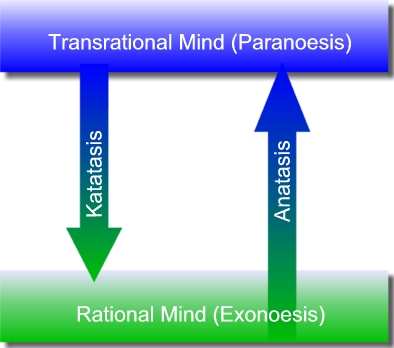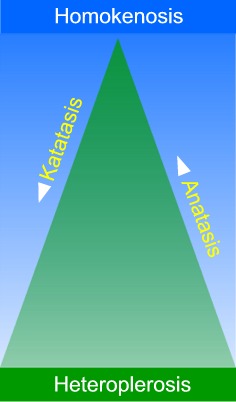
Transrational Thinking (Paranoesis) consists of two fundamental processes:
- Anatasis ( ἀνάτασις), the extension of rational thinking upwards, out of the boundaries of conceptual, analytical thought. It transcends Rational Thinking.
- Katatasis ( κατάτασις), the extension of transrational thinking downwards, translating the Hologemes (holistic structures) of transrational thinking into concepts of rational thinking.

Etymology:
- Anatasis: from Greek ἀνά (ana = up to, upwards, implying motion upwards) and τάσις (tasis = stretching, extension).
- Katatasis: from Greek κατά (kata = down from, downwards, denoting downward motion) and τάσις (tasis = stretching, extension).
Anatasis retrieves knowledge or non-local information directly, without inference, deduction, induction or sensory perception of any kind. The knowledge residing in the Transrational Mind is called Paraepisteme or Direct Knowledge or Transrational Knowledge. Anatasis is a way of knowing and thinking non-conceptually and non-symbolically, i.e. without using linguistic semantics of any kind. Instead it is a way of comprehending the whole without reducing it to its parts (functional decomposition of rational thinking). Transrational Thinking thinks and knows in terms of Hologemes. It constitutes an identity of thinker, thinking, and thought. The object of thought is not separated conceptually from the thinker itself or the thinking agency. Although this may sound like a mystic vision of union, it has nothing to do with mystic experience, as I explained clearly in other essays (see Introduction to Transrational Thinking).
Katatasis is the process of Transrational Thinking that translates, converts, and transforms Paraepisteme to Exoepisteme or Indirect Knowledge or Rational Knowledge. Katatasis is a necessary process in order to make information retrieved in the process of Anatasis available to ordinary, rational thinking by translating the Hologemes of the Transrational Mind into the concepts of the Rational Mind. Without this process, the knowledge and understanding gained while thinking transrationally would be of no purpose other than to the transrational thinker. Katatasis makes communication possible. However, it is imperative to understand that this process of translation inevitably entails loss of information. Since Hologemes are by nature non-conceptual, a conversion into concepts causes a diminuation in scope and depth.
Homokenosis and Heteroplerosis are two methodologies applied in the processes of Anatasis and Katatasis

Etymology:
- Homokenosis: from Greek ὁμός (homos = one and the same) and κενόσις (kenosis = emptying).
- Heteroplerosis: from Greek ἕτερος (heteros = another, different) and πλήρωσις (plerosis = filling, becoming full).
In the process of Anatasis, or the extension of rational mind towards transrational mind or Paranoesis, the method that is applied is Homokenosis, or the emptying of rational mind of all the differentiating concepts and unifying (homos) these concepts into a void, emptied single concept or idea. This universal void idea contains all other, differentiated ideas and concepts of the rational mind in itself. The methodology of emptying is required to reach the level of Paranoesis or transrational mind. As the diagram above illustrates, Homokenosis is also a process of focusing one's attention on a single point or idea, the emptied universal idea or transrational Idea.
In the process of Katatasis, or the extension of transrational mind into the rational mind or Exonoesis, the method that is applied is Heteroplerosis, or filling the rational mind with differentiating concepts. The unity of Paranoesis is broken up into a plurality of individualized, differentiated concepts that are required for rational mind to understand and communicate ideas apprehended in the state of Paranoesis. As the diagram above illustrates, Heteroplerosis is the process of dissipating the focus of one's attention to multiple points or ideas.
Table of differences between Rational and Transrational Thinking
| Rational Thinking | Transrational Thinking |
|---|---|
| Analytical | Non-Analytical, synthetic |
| Conceptual | Non-Conceptual, hologemic |
| Reductionistic | Holistic |
| Divides | Unites |
| Duality of thinker and thought | Identity of thinker and thought |
| Non-contradictory Logic (either-or) | Paradoxical Logic (neither-both) |
| Symbolic (language) | Non-Linguistic |
| Interprets Reality (world construction) | Comprehends Reality directly |
| Gains knowledge by inference, deduction, induction | Gains knowledge by direct insights |
| Conceptual knowledge (Exoepisteme) | Hologemic Knowledge (Paraepisteme) |
| Limited by concepts/language (finite mind) | Unlimited (infinite mind) |
| Communicable | Incommunicable except through Katatasis |
| Relative | Interrelated |
| Embedded in contextual relatons (limited to a specific context of objects based on cultural, social, psychological and other factors) | Beyond contextual relations |
| Dependent on thinker (subjectivity) or community of thinkers (objectivity) | Independent of thinker(s) (transjectivity = beyond the subjective and objective) |
| Involves uncertainty | Certainty |
| Imposing meaning, structure on experience, perception | Non-structured, non-purposive comprehension of reality (non-experiental, non-perceptional) |
| Egocentric, Sociocentric | Cosmocentric |
| Associated with emotions, feelings | Disassociated from emotive or sensory inputs |
| Practical application for guiding behavior/actions (morality, ethics) | No direct practical application. However, can be translated into ethical principles |